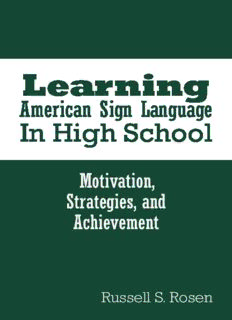
Learning American Sign Language in High School: Motivation, Strategies, and Achievement PDF
Preview Learning American Sign Language in High School: Motivation, Strategies, and Achievement
Learning American Sign Language In High School Motivation, Strategies, and Achievement Russell S. Rosen LEARNING AMERICAN SIGN LANGUAGE IN HIGH SCHOOL L E A R N I N G A M E R I C A N S I G N L A N G U A G E in high school MOTIVATION, STRATEGIES, AND ACHIEVEMENT Russell S. Rosen Gallaudet University Press washington, d.c. Gallaudet University Press Washington, DC 20002 http://gupress.gallaudet.edu © 2015 by Gallaudet University All rights reserved. Published 2015 Printed in the United States of America Library of Congress Cataloging-in-Publication Data Rosen, Russell Scott. Learning American sign language in high school : motivation, strategies, and achievement/Russell S. Rosen. pages cm ISBN 978-1-56368-642-9 (paperback) – ISBN 978-1-56368-643-6 (e-book) 1. American Sign Language—Study and teaching (Secondary)—United States. 2. Sign language—Study and teaching—United States. I. Title. HV2476.4.R67 2015 371.91’246–dc23 2015001655 This paper meets the requirements of ANSI/NISO Z39.48-1992 (Permanence of Paper). To the students and graduates of the Program in the Teaching of American Sign Language as a Foreign Language, Teachers College, Columbia University, New York, New York Contents Preface ix Acknowledgments xi 1 Background 1 2 The Study 16 3 Motivation for Learning American Sign Language as a Foreign Language 30 4 Strategies for Learning American Sign Language 48 5 Learner Achievement 98 6 Conclusion 122 References 129 Appendix A 145 Appendix B 149 Index 153 vii Preface Two issues provided the impetus for this book. One is the growth of pro- grams and classes in American Sign Language (ASL) as a foreign language in United States (U.S.) high schools. The number of A merican high schools with ASL programs and classes increased 4000% between the fi rst na- tional survey conducted by the Center for Applied Linguistics in 1996 and a national survey that I conducted in 2005. The other issue is the dearth of studies on high school learners in ASL classes. In spite of the increase in ASL classes and programs in American high schools, little is known about the learners and how they learn ASL as a second language. No informa- tion is available to inform high school ASL teachers and program admin- istrators on why learners take ASL for foreign language credit, how they learn new signs and grammar, and how their learning determines their achievement in ASL. This book is based on a study that looked at the demographics, motiva- tion, language processing, learning strategies, and course performance of two groups of learners (those with and without learning disabilities) in ASL as a foreign language class. More specifi cally, it examines the characteristics of the learners, the reasons they have for taking ASL, the way they process ASL as a language, their preferred strategies for learning the language, and their performance in ASL classes. Such information will help teachers and school administrators in their recruitment of future learners to ASL classes and in curriculum development and instructional planning. The book begins with the historical background of teaching ASL as a foreign language in American high schools. This history includes the de- bates about the linguistic and foreign language status of ASL, the situation of deaf and hard of hearing learners in public secondary schools, govern- mental recognition of ASL as a language, and processes leading to its in- clusion in the schools. The next section presents the fi ndings of a national ix
Description: